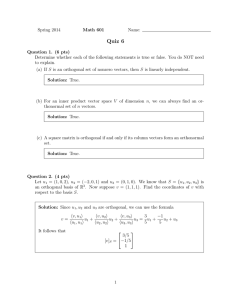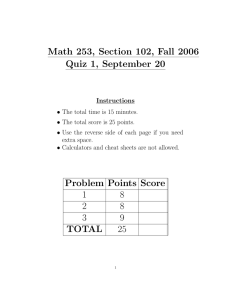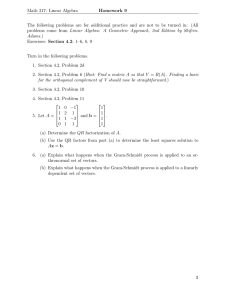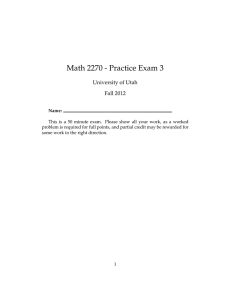Math 2270 Assignment 9 Dylan Zwick Fall 2012
advertisement
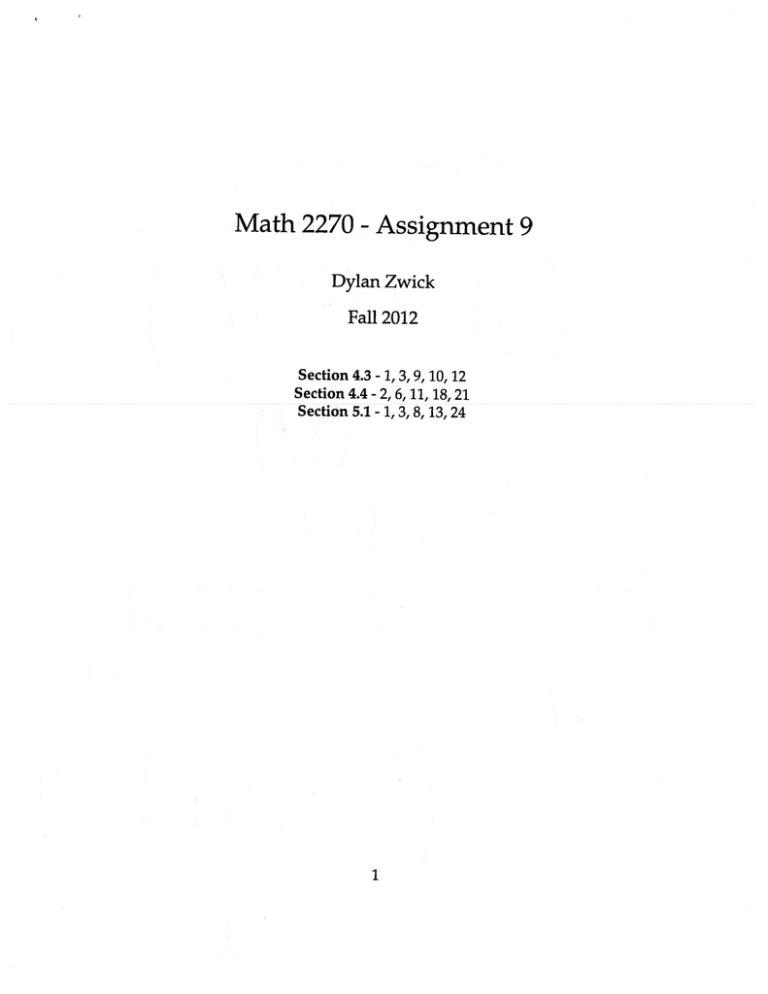
Math 2270 Assignment 9
-
Dylan Zwick
Fall 2012
Section 4.3 1, 3, 9, 10, 12
Section 4.4 2, 6, 11, 18, 21
Section 5.1 1, 3, 8, 13, 24
-
-
-
1
4.3 Least Squares Approximation
-
4.3.1
ith b = 0, 8. 8. 20 at t = 0, 1. 3, 4, set up and solve the normal equa
ATb. For the best straight line find its four heights p
tions ATA$
and four errors c. What is the minimum value E = c + c + e + c?
ATA/’
(
(‘o’Jq
3
H
(L
ATJ,
i
ui
(o3)/
{J
(X(
i
I1L
-
l6J
(g
+ZLlI
-
()
17
(III H
(Ii)
2
E
(/
/
I
A
I
)
3
( 5)
41)
17
Al i
4.3.3 Check that e = b—p = (—1, 3, —5, 3) is perpendicular to both columns
of A. What is the shortest distance
from b to the column space
of A?
11)
/i
I
(ô
O+3-i5±f3=
1Ief(
ILS)l+
3
2 to the same four points,
4.3.9 For the closest parabola b = C + D1 + Et
write down the unsolvable equations Ax = b in three unknowns
ATb (solution
(C, D, E). Set up the three normal equations ATA*
not required).
C
7tij
1
o
13
1
9
(
I
o o\ /
c1
39
i
(
i
(
26
I
I
/\
H
If
OI3
J/
1
OH(1CJ/
(?cJ
AA 9
A
7
r/
( I ()
4.3.10 For the closest cubic b = C + Dt + Et
2 + Ft
3 to the same four points,
write down the four equations Ax = b. Solve them by elimination.
What are p and e?
/o0
C
/1111
I 3 L7
i I6
I I 4
19
(coo
01
0
C) C)
/10
/
1
q7
3
f
3
)
F
0
—S
3
i—i
-
6L{ IC
0 L Lc)
-
L
6
3
pj
Lj7
(o
IC
3
3_
j9
(z
b
F
I
1;;
5
/
3
,. , b,,,) onto the
1
(b
4.3.12 (Recommended) This problem projects b
b in 1 Un
line through a = (1,. , 1). We solve m equations ar
known (by least squares).
.
(a) Solve
b’s.
aTa±
(b) Find e
=
b
aTb
—
to show that § is the mean (the average) of the
a and the variance eU
2 and the standard deviation
(3, 3, 3) is closest to b = (1, 2, 6). Check
(c) The horizontal line 1
that p (3, 3, 3) is perpendicular to e and find the 3 by 3 projec
tion matrix P.
t
(/
1)’
I
((I
J
47)
e
(
/:) /
:
/)
6
c)
-1
3
O
31
\.
‘
4.4 Orthogonal Bases and Gram-Schmidt
-
4.4.2 The vectors (2, 2, —1) and (—1, 2, 2) are orthogonal. Divide them by
their lengths to find orthonormal vectors q
1 and q
. Put those into
9
the columns of Q and multiply QTQ and QQT.
z(a)
317/
ff1
C)
or4 k
“1
show that their product
4.4.6 If Q
1 and Q2 are orthogonal matrices,
QTQ
= I.)
is also an orthogonal matrix. (Use
A-
41
Q1Q2
/
-7
(QiLT(Q,
L]
1
,TQ
v
8
4.4.11 (a) Gram-Schmidt: Find orthonormal vectors q
1 and q
9 in the plane
spannedbya = (1, 3,4, 5, 7) andb = (—6,6,8,0,8).
(b) Which vector in this plane is closest to (1, 0, 0, 0, 0)?
)
-7\/ 1
IOC
3
9
J
T
4
‘9
)
L
joo(\;
57
j
(H
1 $
3LH51
—1
0
I
—
5
-
fcc)
-
4.4.18 (Recommended) Find orthogonal vectors A, B, C by Gram-Schmidt
from a, b, C:
a
=
(1, —1,0,0)
b=(0,1,—1,O)
N
-
I2i-
/lCAVt.
7_i
(!)
A
U
C)
j3
I
—
c=(0,O,i,—1).
Find an orthonormal basis for the column space of A:
1 —2
10
11
13
A
and
b=(3).
Then compute the projection of b onto that column space.
1
A
mJ
0
M
7
zJiT
7’
—9
/tJii
R
f
L
L
L5
LT
4*
-
It
\\
I
S
32’fiT
\Z
11
(
-
5.1 The Properties of Determinants
-
5.1.1 If a 4 x 4 matrix has dct(A)
,
find dt(2A) and dt(—A) and
+
)
IAH)
e4)
12
5.1.3 True of false, with a reason if true and a couriterexample if false:
(a) The determinant of I + A is 1 + dt(A).
(b) The determinant of ABC is ABHC.
(c) The determinant of 411 is
(d) The determinant of AB
(0 0
1
—
BA is zero. Try an example with A
-I
11
I
u11I,c
I
e
I
ff 4-I)
(,4 :
-
d fTh
4
cr’)
1
F
J
/
/ C
(C)t
/0(1
Gi
/
‘4=
(f;)
0 O
()
13
50)
rnq
‘
/‘
CL
fo-/)
5.1.8 Prove that every orthogonal matrix
—1.
(QTQ
I) has determinant 1 or
A B and the transpose rule
(a) Use the product rule ABI
Q
=
L
T
Q
(b) Use only the product rule. If dct(Q) > 1 then dt(Q) dct(Q)
blows up. How do you know this can’t happen to Q?
Qi
(o&H 1&HLQ/
11
12D
50
Pc n
J1 ‘y
00
k
jf
rio//
14
I_/f
educe A to U and find dct(A)
product of the pivots:
/1 1 i\
A( 122)
1 2 3)
/1 2 3
A=( 223
\3 3 3
()
t()
—)
(o
tIJ
(A) HP
/
[RJ
7)
3 33/
/o-
/1
) I
Z
O-3
O
(A /
15
(-i)
(-)
5.1.24 Elimination reduces A to U. Then A
/1
/33 4’\
Arr(687)=12
-1
5 -9)
=
LU:
OO’\/33 4\
1O)f02_1)LU.
4 1) \O 0 -1)
L’A.
1
Find the determinants of L, U, A, U’L’, and U
()
()
AH ILl lL’/ ((-)
+ (u ‘j
/
A4- (t’)
(u
‘L
‘
d+ o -y4-) dfF)
16
